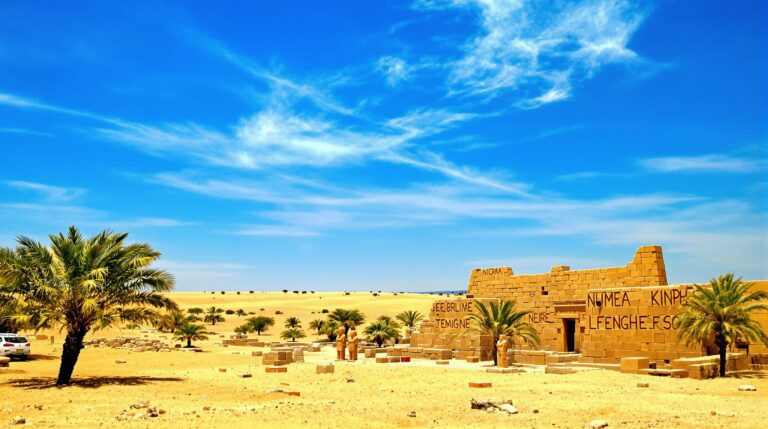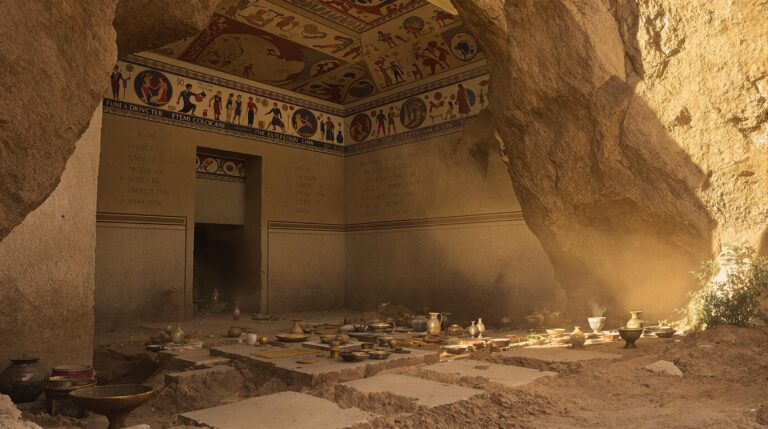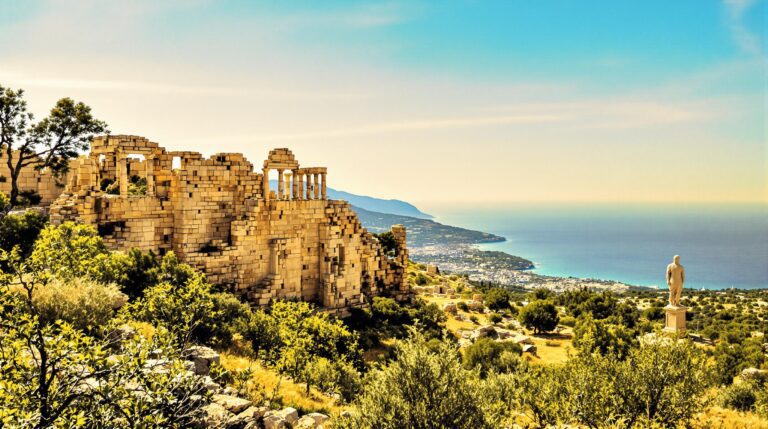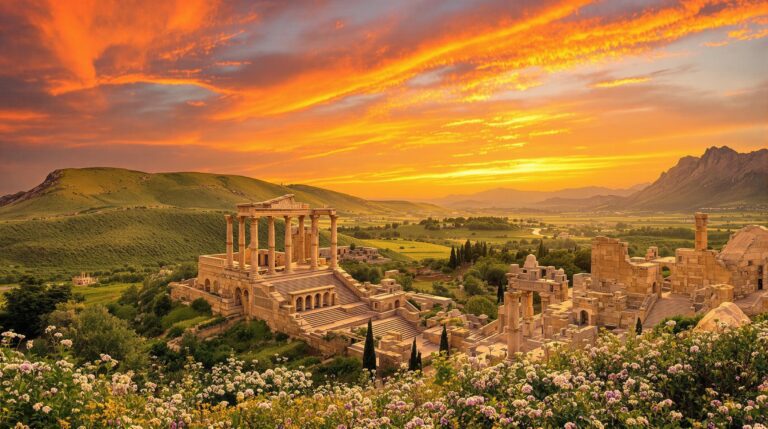The Rise and Fall of Carthage: From Empire to Ashes
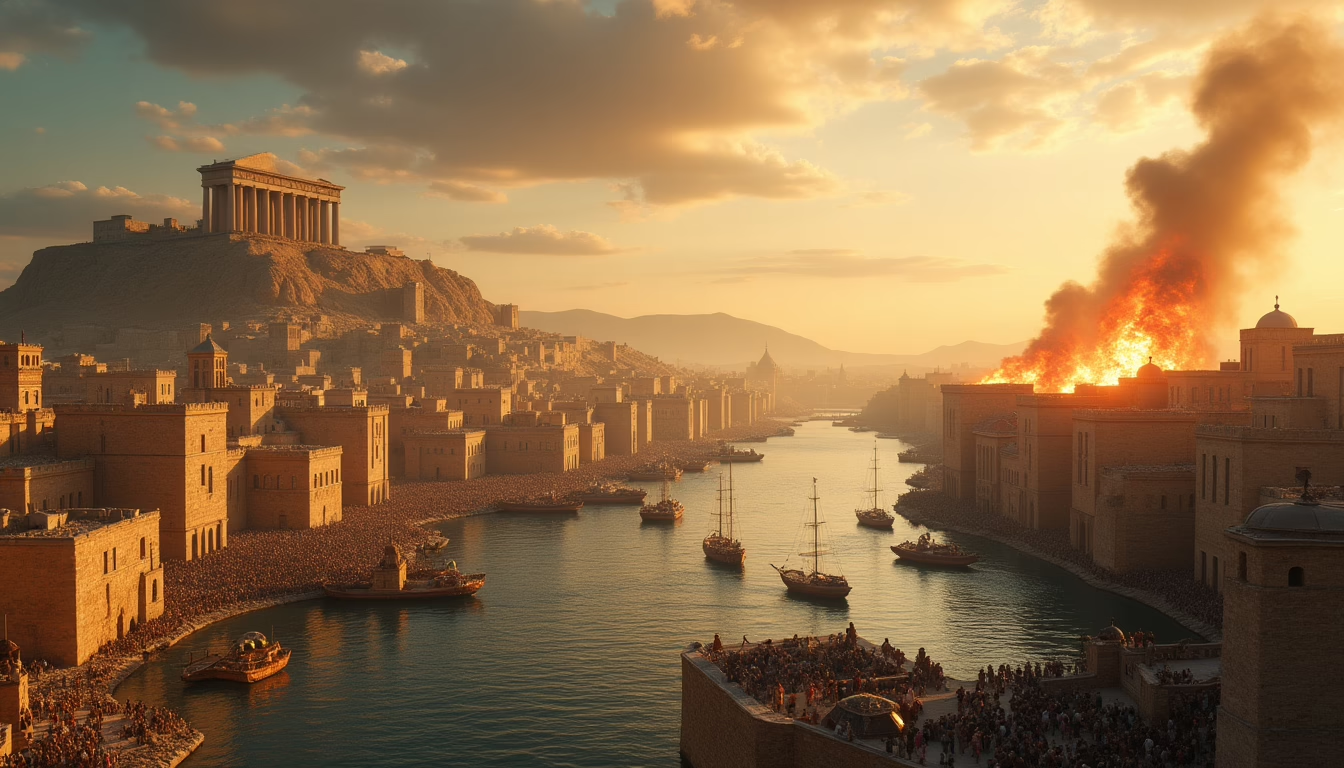
The rise and fall of Carthage presents a compelling study of ambition and conflict.
Originally a Phoenician outpost, it transformed into a significant maritime power, thriving on trade and cultural richness.
However, its rivalry with Rome proved disastrous.
The Punic Wars showcased both strategic brilliance and profound missteps. As the ashes settled after the Third Punic War, one must ponder: what lessons linger from Carthage’s storied existence and ultimate demise?
TL;DR
Hide- Carthage was founded by Phoenician exiles from Tyre, evolving into a major maritime power through trade and military expansion.
- The city's governance featured a mix of oligarchic control and citizen engagement, with merchant families exerting significant political influence.
- Carthage's military prowess initially dominated the First and Second Punic Wars, showcasing innovative tactics and strong naval capabilities against Rome.
- Following Hannibal's defeats, Rome's strategic adaptations, particularly the Fabian Strategy, shifted the balance of power, leading to Carthage's decline.
- The Third Punic War culminated in the complete destruction of Carthage, marking the end of its empire and dominance in the Mediterranean.
Founding of Carthage: A Phoenician Outpost Turned Powerhouse
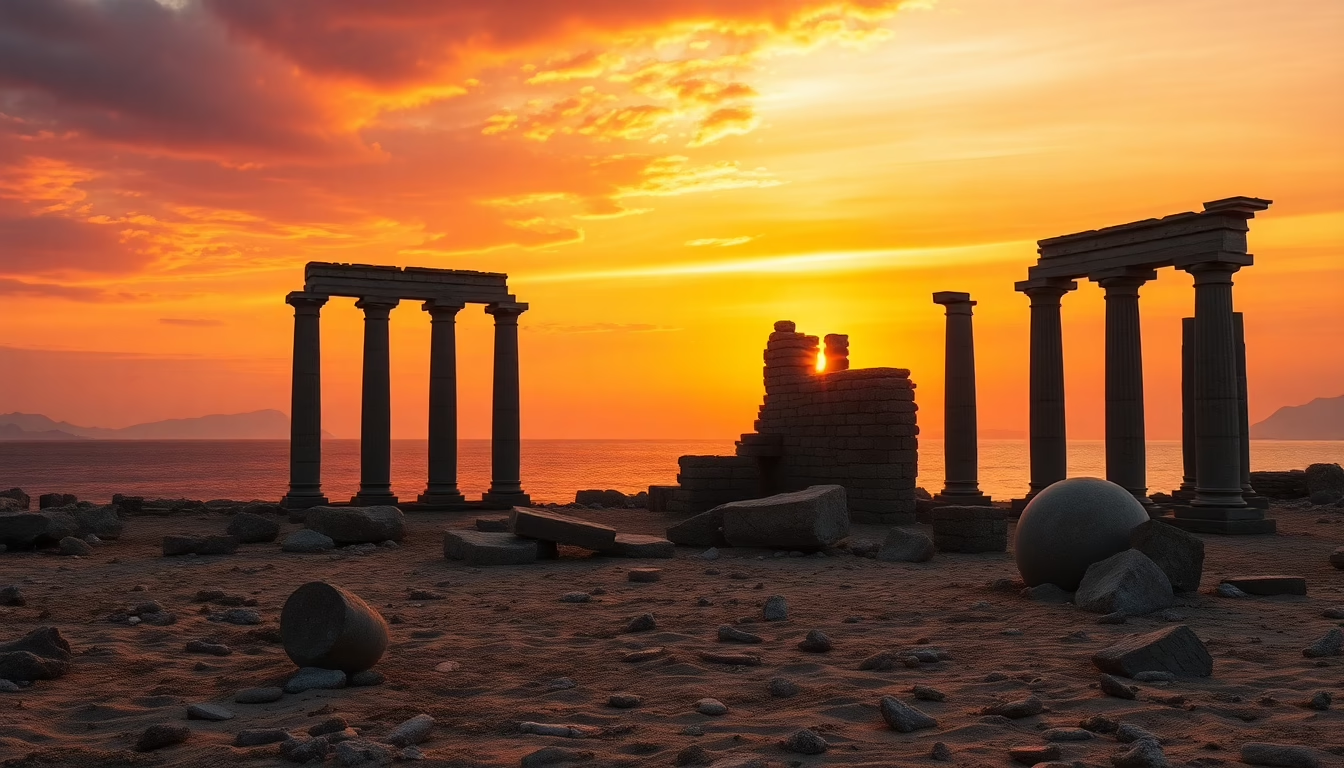
The founding of Carthage is steeped in the legendary narrative of Queen Dido, whose cunning and resilience laid the groundwork for a settlement that would evolve into a formidable power.
Initially established as a Phoenician outpost, Carthage leveraged its strategic maritime location to expand its influence and dominate trade across the Mediterranean.
This transformation from a fledgling colony to a thriving economic powerhouse raises intriguing questions about the factors that facilitated such rapid growth.
The Legend of Queen Dido and Carthage’s Beginnings
The legend of Queen Dido serves as an enchanting narrative that intertwines myth with the historical roots of Carthage, a city founded by Phoenician exiles from Tyre.
This tale not only highlights Dido’s determination and resourcefulness but also underscores Carthage’s strategic position along essential Mediterranean trade routes.
Such geographical advantages would ultimately transform this outpost into a formidable powerhouse in the ancient world.
Mythological Origins Rooted in Escape from Tyre
Although often overshadowed by its military conquests, the mythological origins of Carthage reveal a narrative steeped in resilience and ambition, encapsulated in the legend of Queen Dido.
Her flight from Tyre symbolizes not merely escape, but a quest for autonomy and renewal. This foundational myth underscores Carthage’s identity as a bastion of freedom, where ambition transformed adversity into a thriving cultural and economic hub.
Strategic Location Along Mediterranean Trade Routes
Carthage’s strategic location along key Mediterranean trade routes served as a catalyst for its transformation from a humble Phoenician outpost into a formidable economic powerhouse.
This advantageous position allowed Carthage to thrive through:
- Flourishing commerce and wealth
- Cultural exchanges and innovation
- Strategic alliances and power consolidation
- Maritime dominance and defense
- Expansion of influence across the Mediterranean
These elements forged a legacy of ambition and resilience.
Early Expansion and Maritime Strength
Carthage emerged as a formidable maritime power through its strategic expansion across North Africa and the Mediterranean.
This growth not only established a vast naval network but also positioned the city as a dominant force in trade, particularly in coveted purple dye, metals, and agricultural goods.
The interplay of military prowess and economic influence laid the groundwork for Carthage’s ascent in the ancient world.
Carthage’s Growing Naval Network Across North Africa and the Mediterranean
As the Phoenician outpost of Carthage evolved into a formidable maritime power, its strategic location along the North African coast facilitated the expansion of an extensive naval network throughout the Mediterranean.
This network fostered:
- Unyielding ambition
- Cultural exchanges
- Economic opportunities
- Military prowess
- A sense of unity
Carthage’s mastery of the seas symbolized freedom, allowing the city to assert its influence and shape destiny.
Trade Dominance in Purple Dye, Metals, and Agriculture
While the expansion of Carthage’s naval network enabled its rise as a dominant power in the Mediterranean, it was the city’s strategic control over lucrative trade goods that solidified its economic prowess.
The production of purple dye, the mastery of metalwork, and agricultural surplus created wealth and influence, allowing Carthage to establish itself as a critical hub that shaped regional commerce and power dynamics.
Carthaginian Society and Culture
Carthaginian society was characterized by a complex governance structure dominated by the Suffetes, who wielded significant political power alongside an intricate assembly.
The intertwining of religion with daily life was evident in their sacred practices and rituals, reflecting a deep reverence for deities that shaped cultural norms and values.
Additionally, the rich artistic expressions and unique language of the Carthaginians reveal a lively civilization that thrived on trade and cultural exchange, influencing its legacy in the ancient world.
Structure of Government and the Role of the Suffetes
Carthage’s government exemplified a distinctive fusion of oligarchic elements and public assemblies, reflecting the complexities of its societal structure.
The suffetes, serving as dual chief magistrates, wielded significant power while also being influenced by the wealth and interests of dominant merchant families.
This dynamic interplay between governance and economic influence raises questions about the true nature of political authority in Carthaginian society.
Unique Blend of Oligarchy and Public Assemblies
Although often overshadowed by its military exploits, the governance of Carthage reveals a complex interplay between oligarchic control and participatory public assemblies.
This unique structure allowed for:
- Limited citizen engagement
- Elitist decision-making
- A facade of democracy
- Struggles for power
- The tension between wealth and the voice of the people
Such dynamics shaped the very essence of Carthaginian identity and aspiration for freedom.
Influence of Merchant Families and Wealth
The governance of Carthage was profoundly influenced by its merchant families, whose wealth and economic clout shaped both societal norms and political structures.
These affluent dynasties wielded substantial power, often overshadowing traditional authority. Their interests dictated trade policies, military funding, and diplomatic relations, reflecting a society where financial prowess translated into political leverage.
Ultimately, commerce intertwined with governance in a complex tapestry of influence.
Religion and Sacred Practices
Carthaginian society was deeply intertwined with the worship of deities such as Baal Hammon, Tanit, and various astral figures, reflecting a complex spiritual landscape.
This religious framework not only shaped daily life but also sparked intense debate, particularly regarding the controversial practice of child sacrifice.
The examination of these sacred practices offers critical insights into the values and beliefs that underpinned Carthaginian culture and ultimately influenced its fate.
Worship of Baal Hammon, Tanit, and Astral Deities
As the heart of Carthaginian society, the worship of deities such as Baal Hammon and Tanit revealed a complex interplay of religious devotion and cultural identity.
This veneration reflected:
- Deep-rooted traditions
- A yearning for divine favor
- Unity among diverse populations
- Expressions of communal strength
- Reverence for the cosmos
Such practices underscored the Carthaginians’ quest for meaning and identity within their lively society.
Debated Evidence of Child Sacrifice Rituals
Although the topic remains contentious among historians and archaeologists, evidence suggesting the practice of child sacrifice in Carthaginian rituals continues to provoke intense debate.
Archaeological findings, including burial sites and inscriptions, raise questions about the societal norms surrounding these practices. Critics argue that misinterpretation may skew perceptions, while proponents assert that such rituals were integral to appeasing deities, reflecting deep-seated religious convictions within Carthaginian culture.
Language, Art, and Daily Life
Carthaginian society was characterized by a vibrant mosaic of language and artistic expression, primarily through the use of the Punic language, which bore significant influences from its Phoenician roots.
This linguistic heritage was paralleled by a flourishing of artistic endeavors, evident in the intricate pottery and jewelry that reflected both local craftsmanship and external influences from Mediterranean cultures.
These elements not only served functional purposes in daily life but also conveyed the complex identity and values of Carthaginian civilization.
Use of the Punic Language and Adaptations from Phoenician
While the Punic language served as a crucial vehicle for communication and cultural expression in ancient Carthage, its roots in Phoenician reveal a complex interplay of heritage and adaptation.
This linguistic evolution reflected the society’s resilience and identity, shaping their values and daily interactions:
- Rich oral traditions
- Deep-rooted cultural narratives
- Shared community identity
- Expressions of trade and diplomacy
- Preservation of history and beliefs
Pottery, Jewelry, and Artistic Influence from Across the Sea
The artistic expression of Carthage was markedly influenced by interactions with neighboring cultures, particularly through the mediums of pottery and jewelry.
These artifacts not only showcased intricate designs and lively colors but also reflected a synthesis of various artistic traditions.
The fusion of styles underscored Carthage’s role as a cultural crossroads, revealing the society’s adaptability and openness to external influences in its daily life.
The First Punic War: Rome Meets Its Rival
The First Punic War marked a critical juncture in the power dynamics of the ancient Mediterranean, as Rome sought to assert itself against its formidable rival, Carthage, primarily through the struggle for control over Sicily.
This conflict not only underscored the importance of naval supremacy but also illustrated the shifting tides of military strategy as Rome adapted to maritime warfare.
Ultimately, the war culminated in a treaty that imposed harsh terms on Carthage, setting the stage for Rome’s ascendance and reshaping the geopolitical landscape.
Battle for Sicily and Naval Supremacy
The First Punic War marked a critical turning point in the struggle for dominance over Sicily, as Rome confronted Carthage’s established naval prowess.
Despite their initial lack of experience at sea, Roman leaders rapidly innovated shipbuilding techniques to challenge the Carthaginian fleet.
Meanwhile, Carthage’s superior tactics and early advantages posed significant obstacles, highlighting the complexities of this maritime conflict.
Rome’s Naval Inexperience and Rapid Shipbuilding
Naval supremacy emerged as a crucial determinant in the First Punic War, highlighting Rome’s initial inexperience in maritime warfare.
As Rome commenced on rapid shipbuilding, the stakes escalated, revealing both ambition and vulnerability.
- A fleet born from desperation
- Menacing waves of uncertainty
- The weight of untested sails
- The cry for dominance
- A struggle for survival and freedom
Carthaginian Tactics and Early Advantages
Carthaginian tactics during the First Punic War showcased a sophisticated understanding of maritime warfare that initially placed Rome at a distinct disadvantage.
Their adept use of triremes, complemented by experienced sailors and strategic coastal maneuvering, allowed for rapid dominance in naval engagements.
This mastery not only threatened Roman supply lines but also underscored the importance of naval supremacy in the struggle for Sicily.
Treaty and Terms of Defeat
The Treaty of Lutatius marked a pivotal moment in the First Punic War, as it resulted in Carthage’s significant loss of Sicily and the imposition of hefty indemnity payments.
This defeat not only diminished Carthage’s territorial influence but also fostered a deep-seated resentment that would later fuel further hostilities between the two powers.
As the terms of defeat sank into the collective consciousness of Carthaginian society, they sowed the seeds for future conflict, suggesting that the consequences of war extend far beyond immediate territorial losses.
Carthage’s Loss of Sicily and Indemnity Payments
As the echoes of the First Punic War faded, the loss of Sicily marked a pivotal shift in the balance of power in the ancient Mediterranean.
Carthage faced not only territorial defeat but also crippling indemnity payments that drained its resources.
This ignominious chapter evoked:
- Anguish over lost glory
- Economic despair
- Erosion of naval supremacy
- Diminished influence
- Seeds of resentment
Lasting Resentment and the Seeds of Future Conflict
Resentment simmered beneath the surface of the treaty that ended the First Punic War, laying a fraught foundation for future hostilities between Rome and Carthage.
The harsh indemnities and territorial losses bred bitterness in Carthage, undermining any hope for reconciliation.
This animosity festered, ultimately shaping the ambitions of both powers and foreshadowing the inevitable clash that would define their contentious rivalry.
Hannibal and the Second Punic War
Hannibal’s audacious crossing of the Alps marked a pivotal moment in the Second Punic War, driven by an oath of vengeance against Rome.
This bold maneuver set the stage for a series of fierce confrontations, including the stalemate that ensued as Roman forces regrouped and mounted counterattacks.
Ultimately culminating in the decisive Battle of Zama, these events not only signified a turning point for Carthage but also heralded its decline, reshaping the balance of power in the ancient world.
The Oath of Vengeance and Crossing the Alps
Hannibal’s audacious oath of vengeance set the stage for one of history’s most remarkable military campaigns during the Second Punic War.
His strategic crossing of the Alps, accompanied by war elephants, not only showcased his innovative tactics but also caught Roman forces off guard, leading to decisive victories at Trebia, Lake Trasimene, and Cannae.
These early triumphs underscored Hannibal’s ability to exploit terrain and surprise, fundamentally challenging Roman dominance in the Mediterranean.
Hannibal’s Strategic March With War Elephants
The audacious endeavor of crossing the Alps marked a pivotal moment in the Second Punic War, showcasing Hannibal’s unparalleled strategic ingenuity. His march, laden with war elephants, symbolized resilience and defiance against Rome.
Key elements of this extraordinary campaign included:
- Unyielding determination
- Psychological warfare
- Innovative tactics
- The element of surprise
- Unforgettable leadership
These factors coalesced to challenge the might of an empire.
Early Victories: Trebia, Lake Trasimene, and Cannae
While the audacity of Hannibal’s Alpine crossing captured the imagination of many, it was his subsequent early victories at Trebia, Lake Trasimene, and Cannae that solidified his status as a military genius.
Each battle showcased his exceptional tactical acumen, employing ambushes and psychological warfare to exploit Roman weaknesses, ultimately reshaping the landscape of power and igniting a fervent desire for freedom among his followers.
Stalemate and Roman Counterattacks
As the Second Punic War progressed, the Roman Republic faced the formidable challenge of countering Hannibal’s strategic ingenuity, leading to a period of stalemate.
In response, Roman generals, particularly Scipio Africanus, implemented the Fabian strategy, emphasizing cautious engagement while adapting to the Carthaginian threat.
This shift ultimately culminated in Scipio’s daring invasion of Africa, forcing Hannibal to retreat and fundamentally altering the war’s trajectory.
Fabian Strategy and Roman Adaptation
Although Hannibal’s military genius initially placed Rome on the defensive during the Second Punic War, the Roman republic’s strategic adaptation, particularly through the implementation of the Fabian Strategy, marked a pivotal shift in the conflict.
This cautious approach aimed to preserve resources and morale, evoking feelings of:
- Resilience
- Patience
- Courage
- Unity
- Hope
Each element contributed to Rome’s eventual resurgence and determination for freedom.
Scipio Africanus Invades Africa and Forces Retreat
Scipio Africanus launched a bold campaign into North Africa, a decisive maneuver that ultimately forced Hannibal to retreat from Italy and reestablish his defenses at home.
This strategic invasion not only disrupted Carthaginian plans but also demonstrated the shifting tides of the Second Punic War.
Scipio’s audacity highlighted the Roman determination for victory, reshaping the battlefield dynamics and paving the way for future triumphs.
The Battle of Zama and Carthage’s Decline
The Battle of Zama marked a crucial turning point in the Second Punic War, culminating in Hannibal’s decisive defeat and signaling the beginning of Carthage’s decline.
Following this catastrophic loss, the city-state faced crippling peace negotiations that would greatly diminish its power and strip away essential overseas territories.
This outcome not only reshaped the balance of power in the Mediterranean but also set the stage for the eventual downfall of Carthage as a dominant force in the region.
Hannibal’s Final Defeat and Peace Negotiations
How did a master strategist like Hannibal ultimately face defeat in the pivotal Battle of Zama?
His once-unmatched tactics faltered against Scipio’s ingenuity, leading to Carthage’s despair.
This defeat ushered in negotiations that would redefine their existence.
- The weight of crushed dreams
- The echoes of lost freedom
- The cries of a fallen empire
- The desperation of a broken spirit
- The shadows of unfulfilled potential
Reduced Power and Loss of Overseas Territories
Hannibal’s defeat at the Battle of Zama marked a significant turning point for Carthage, leading to a cascade of consequences that severely diminished its power and influence.
The loss of territories, coupled with crippling reparations, stripped Carthage of its economic strength and strategic footholds.
This decline not only weakened its military but also curtailed its ability to project power across the Mediterranean.
The Third Punic War and Final Destruction
The Third Punic War marked a pivotal moment in the conflict between Rome and Carthage, driven by growing Roman animosity and Cato the Elder’s relentless calls for action against the city.
As tensions escalated, Rome initiated a brutal siege that would ultimately lead to Carthage’s complete annihilation.
This final act not only symbolized the end of Carthaginian power but also reflected the broader themes of vengeance and imperial ambition that characterized Roman expansionism.
Cato’s Warning and Roman Hostility
Cato’s infamous declaration, “Carthago delenda est,” encapsulated Roman sentiment towards Carthage, serving as a rallying cry for those advocating war.
The escalating demands placed upon Carthage by Rome highlighted a calculated strategy to provoke conflict, where each pretext served to justify increasing hostilities.
As tensions mounted, the question arose: was the desire for destruction rooted in legitimate concerns, or was it an expression of deeper Roman animosity?
“Carthago delenda est” and the Push for War
Amidst the fervent political climate of the late Republic, a singular phrase echoed through the halls of Roman power: “Carthago delenda est,” or “Carthage must be destroyed.”
This call to arms, famously championed by Cato the Elder, encapsulated the growing animosity towards Carthage, igniting a relentless push for the Third Punic War.
- Fear of Carthaginian resurgence
- Desire for vengeance
- Nationalistic fervor
- Economic ambitions
- Political unity through war
Rome’s Pretexts and Escalating Demands
As tensions simmered in the Mediterranean, Rome’s escalating demands on Carthage served as a pretext for the inevitable outbreak of the Third Punic War.
Cato’s relentless call for Carthage’s destruction reflected deep-seated Roman hostility and a desire for dominance.
Each demand amplified the fractures in their relationship, ultimately leading to a catastrophic conflict that would obliterate Carthage and reshape the Mediterranean landscape forever.
Siege and Destruction of the City
The siege of Carthage marked a pivotal moment in urban warfare, as the city’s defenders employed desperate tactics to resist the overwhelming Roman forces.
Despite their fierce resistance, the systematic destruction of Carthage culminated in not only the city’s physical obliteration but also the enslavement of its surviving population.
This brutal campaign raises questions about the nature of warfare and the lengths to which a civilization will go to eradicate its rival.
Resistance of the Carthaginians and Urban Warfare
Throughout the prolonged conflict of the Third Punic War, the Carthaginians demonstrated remarkable resilience and tactical ingenuity in their defense of the city against Roman forces.
Their urban warfare strategies showcased their determination to protect their homeland, reflected in:
- Unyielding spirit of the defenders
- Ingenious use of fortifications
- Coordination among citizens
- Resourcefulness in limited supplies
- Deep-rooted desire for freedom
These factors illustrated their unwavering commitment to resist.
Systematic Destruction and Enslavement of Survivors
Despite the fierce resistance displayed by the Carthaginians, the relentless Roman siege ultimately culminated in the systematic destruction of Carthage.
The Romans not only razed the city but also enslaved countless survivors, erasing a lively culture and subjugating its people.
This calculated annihilation serves as a stark reminder of the consequences of imperial ambition and the fragility of freedom in the face of overwhelming power.
Legacy and Rediscovery
The legacy of Carthage, once a formidable power in the ancient Mediterranean, continues to resonate through archaeological discoveries beneath modern Tunis, revealing layers of its complex history.
These findings not only illuminate the daily lives and innovations of Carthaginian society but also underscore its profound influence on Roman culture and the wider Mediterranean world.
As historians and archaeologists unravel these remnants, the enduring significance of Carthage shapes contemporary understandings of ancient civilizations and their interconnectedness.
Archaeological Finds Beneath Modern Tunis
Beneath the bustling streets of modern Tunis lies a vibrant mosaic of Carthaginian history, with archaeological finds revealing remnants of temples, ports, and homes.
Inscriptions and burial sites unearthed in this area provide invaluable insights into the daily lives and cultural practices of this ancient civilization.
These discoveries not only enhance understanding of Carthage’s legacy but also invite contemplation on the enduring impact of its past on contemporary society.
Remnants of Temples, Ports, and Homes
Archaeological excavations in modern Tunis have disclosed a lively fabric of Carthaginian history, revealing remnants of temples, ports, and homes that once thrived in this ancient city.
These findings evoke a profound sense of connection to the past:
- Intricate mosaics celebrating daily life
- Stone foundations whispering stories of resilience
- Port structures hinting at maritime prowess
- Temple ruins echoing spiritual devotion
- Residential layouts reflecting communal harmony
Additionally, the ongoing research into Cleopatra’s burial site continues to intrigue historians and archaeologists alike.
Inscriptions and Burial Sites That Shed Light on Daily Life
Amidst the layers of Carthaginian civilization uncovered in Tunis, inscriptions and burial sites emerge as poignant indicators to daily life and cultural practices.
These artifacts reveal intricate social structures, religious beliefs, and daily routines, offering a glimpse into the values and aspirations of a once-great empire.
Each discovery invites reflection on the enduring human experience, transcending time and geography in the pursuit of freedom and understanding.
Carthage’s Impact on Rome and the Mediterranean
Carthage’s naval innovations markedly shaped Roman maritime practices, allowing the latter to dominate Mediterranean waters.
Additionally, the enduring influence of Carthaginian trade routes and agricultural techniques continued to resonate in North Africa long after its fall, illustrating a complex legacy that transcended mere conquest.
This interplay of adaptation and persistence raises questions about how cultures shape one another in the face of historical upheaval.
Roman Adaptations of Carthaginian Naval Techniques
The adaptation of Carthaginian naval techniques marked a significant turning point in Roman maritime strategy, reflecting the deep-seated influence of Carthage on Rome’s development as a naval power.
This transformation encompassed:
- Enhanced ship designs for speed
- Tactical innovations in naval engagements
- Advanced navigation methods
- Superior logistics and supply chains
- Strategic use of coastal geography
Such advancements propelled Rome toward dominance in the Mediterranean.
Lingering Influence in North African Trade and Agriculture
Carthaginian innovations in maritime practices extended far beyond naval warfare, leaving an indelible mark on North African trade and agriculture that Rome would come to exploit.
Their sophisticated trading networks and agricultural techniques facilitated the exchange of goods and ideas, shaping the Mediterranean economy.
Ultimately, Carthage’s legacy fostered economic interdependence, highlighting the enduring impact of their practices long after their empire’s demise.
Wrapping Up
The story of Carthage serves as a poignant reminder of the impermanence of power and the fragility of human ambition.
While some may argue that its fall was inevitable, one cannot overlook the resilience and innovation that defined this once-great civilization.
The ashes of Carthage, now a haunting echo in history, compel us to reflect on the lessons of hubris and the relentless pursuit of greatness, urging contemporary societies to tread carefully on the path of ambition.
